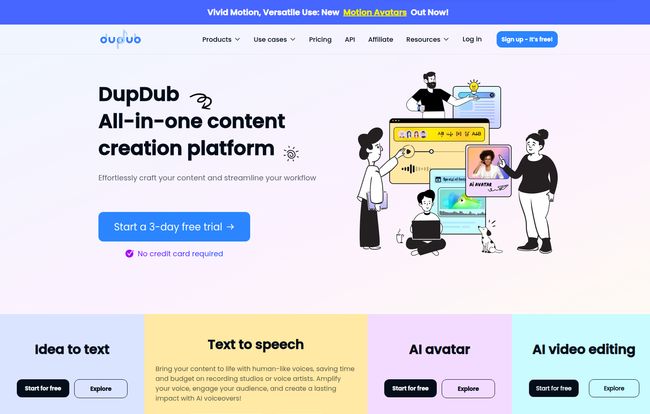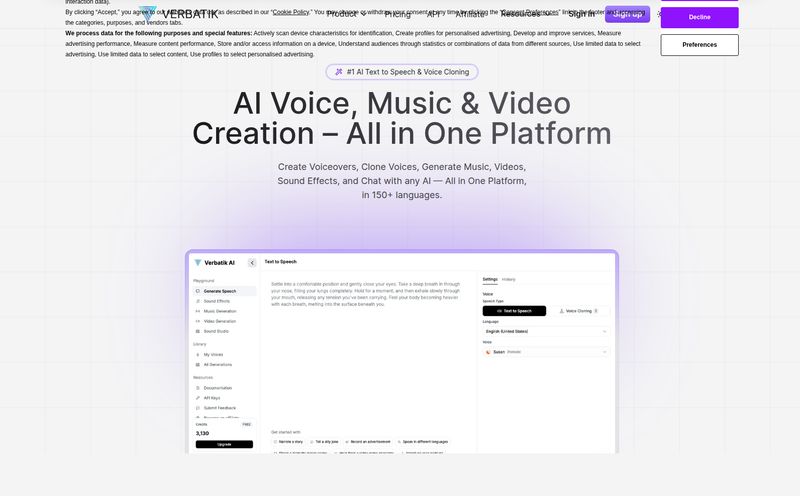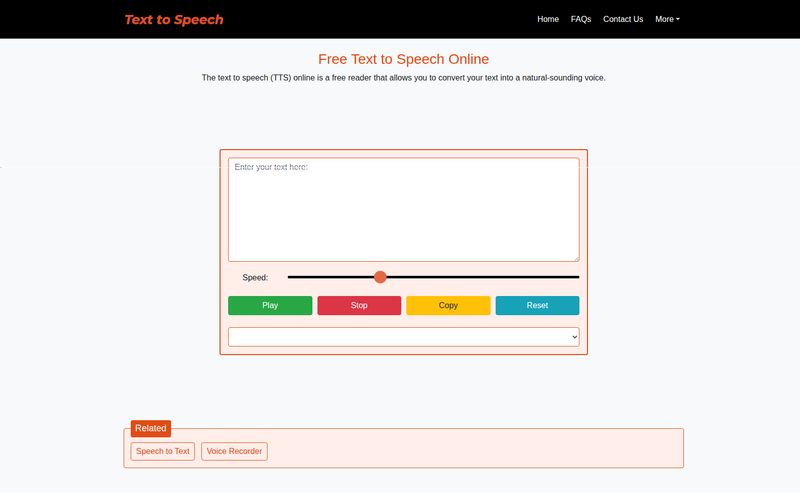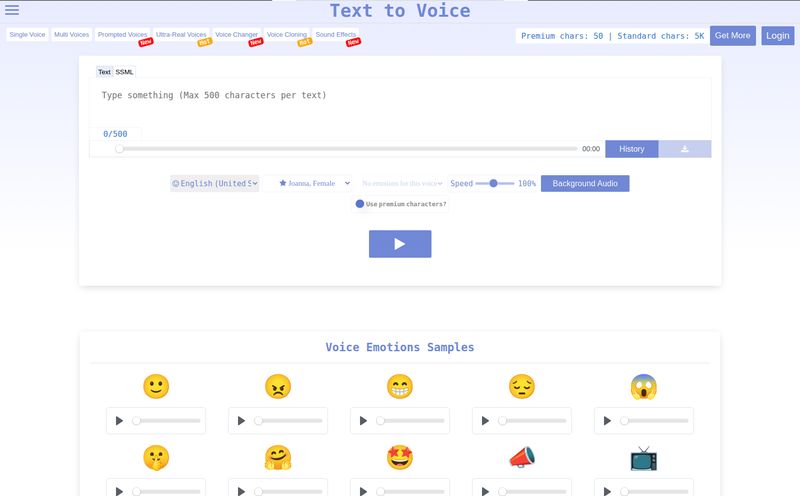As content creators, we're all juggling a dozen different hats. One minute you're a writer, the next a video editor, then a voiceover artist, and maybe even a graphic designer before lunch. The subscription list for all the different tools starts to look like a phone bill. So whenever a platform comes along promising to be an “all-in-one” solution, my ears perk up. But my skepticism meter goes way up, too.
I've seen so many platforms that claim to do it all, but end up being a master of none. A jack-of-all-trades, sure, but the output is... well, you know. A little bit clunky. A little bit off. So when I started seeing DupDub pop up, billing itself as a full-blown AI content creation platform, I had to see what the fuss was about.
So, What's the Big Deal with DupDub Anyway?
At its heart, DupDub started as a really powerful text-to-speech (TTS) tool. And it still excels there. We're talking over 300 different AI voices, dripping with different emotions and styles. It's not the robotic, monotone voice from your old GPS. No, this is different. But it's grown into so much more than just a voice generator.
Think of it less as a single tool and more like a digital Swiss Army knife for creators. They’ve packed in an entire suite of AI-powered features:
- Text-to-Speech (TTS): The core engine, turning your scripts into high-quality audio.
- AI Voice Cloning: Yep, you can create a digital replica of your own voice. More on this later, because it's pretty wild.
- AI Avatars & Video: Create videos with AI presenters without ever needing to step in front of a camera.
- AI Writing Assistant: To help you bust through writer's block and get that script finished.
- AI Art & Image Generation: Need a custom thumbnail or an illustration for your blog? It’s in there.
It's an ambitious package. They're trying to be the go-to spot for everything from your podcast audio to your YouTube video's visuals. The question is, can they pull it off?
The Core of It All: DupDub's AI Voices and Cloning
More Voices Than You Can Shake a Stick At
Okay, the main attraction for most people will be the text-to-speech. And I have to say, the selection is impressive. You're not just picking 'Male Voice 1' and 'Female Voice 2'. You can filter by use case (like 'narration' or 'advertisement'), by emotion (happy, sad, angry), and by age. It gives you a level of control that's genuinely useful. I’ve spent hours on other platforms trying to find a voice that just sounded... right. Here, the options are so plentiful that the search is much faster.
The quality is, for the most part, excellent. Is it perfect? No. Sometimes an AI voice will place emphasis on a weird syllable, but the built-in editor lets you tweak pronunciation and pacing. It’s a far cry from the choppy AI voices of just a few years ago. It feels like we're on the cusp of AI audio being truly indistinguishable from human speech, and DupDub is right at the front of that race.
The Sci-Fi Magic of Voice Cloning
Now this is where things get interesting. DupDub offers a professional voice cloning service. You provide a sample of your voice, and their AI creates a digital version of it. I've always felt that the biggest hurdle for creators who want to scale is... themselves. You only have one voice and so many hours in the day.
Imagine being able to feed a script into a machine and have it read back in your own voice, with your own cadence. You could narrate audiobooks, create consistent voiceovers for a series of tutorials, or update old content without having to re-record everything from scratch. From a branding perspective, this is huge. It ensures consistency across all your audio content. Of course, the classic argument stands: an AI clone won't have the soul or the spontaneous emotion of a real human performance. And that's true. But for straightforward narration and informational content? It's an absolute game changer.
Beyond Just Audio: The Full AI Creative Suite
This is where DupDub tries to separate itself from the pack. It isn’t just an audio tool. They've built an entire ecosystem around content creation. The AI video tools let you sync your generated audio with an AI avatar, creating simple-but-effective videos for social media or corporate training. The AI writer is a handy little assistant for drafting scripts or blog posts (like this one... just kidding. Or am I?).
Having all these tools under one roof is the real value proposition. It stops the frantic tab-switching between your script doc, your TTS software, your video editor, and your stock photo site. It streamlines the workflow. That’s not just a convenience; it’s a time-saver. And time, as we all know, is money.

Visit DupDub
Let's Talk Turkey: Breaking Down DupDub's Pricing
Alright, this is the part everyone's waiting for. A tool can have all the cool features in the world, but if the pricing is out of whack, it's a no-go. DupDub's pricing model is... interesting. It's primarily based on a credit system, which can be a little confusing at first glance.
Think of it like going to an arcade. You buy a bucket of tokens (credits), and each game (each AI feature) costs a certain number of tokens to play. Here’s a simplified look at their main subscription plans:
| Plan | Price (Monthly) | Key Features | Best For |
|---|---|---|---|
| Free | $0 | 3-day all-access trial, then 20 credits/day, 1,000 chars/conversion, standard voices, 1 cloned voice. | Trying it out, very light users. |
| Personal | $19 | 200 credits/month, 1 hr audio download, standard & premium voices, 1 cloned voice. | Hobbyists, small projects. |
| Professional | $59 | 1,000 credits/month, 5 hrs audio download, all voices, 5 cloned voices. | Serious creators, freelancers. |
| Ultimate | $99 | 3,000 credits/month, 10 hrs audio download, all voices, 10 cloned voices. | Agencies, power users. |
Note: Prices are lower if you pay annually. They also have Pay-as-you-go and Enterprise options.
The credit usage varies. For example, a high-quality voiceover might cost more credits per character than a standard one. AI image generation costs a set number of credits per image. You have to be mindful of your usage, but it also means you're only paying for the specific heavy-duty features you actually use. It’s a flexible system, but it does require a little bit of a learning curve to manage your credits effectively.
So, Who is This Really For?
After playing around with the platform, I can see a few groups getting a ton of value here.
YouTubers and Podcasters are the most obvious fit. The ability to generate high-quality voiceovers, create faceless video content with avatars, and even get help writing scripts is a massive workflow enhancement. For channels that rely on narration, this could cut production time in half.
Marketing and Social Media Managers could also have a field day. Need a quick voiceover for an Instagram Reel? Done. Need an animated avatar to announce a new feature? Easy. The speed at which you can generate multimedia assets is a huge plus in the fast-paced world of digital marketing.
Finally, E-learning and Corporate Trainers. Creating training modules can be a slog, especially when updates are needed. With voice cloning and AI avatars, you can update course material quickly and consistently without having to book a studio or a voice actor for a minor change.
My Final Verdict: Is DupDub a Worthy Investment?
So, is DupDub the magical all-in-one tool we've all dreamed of? It's getting damn close. The sheer breadth of features packed into one platform is its biggest strength. The quality of the core TTS and voice cloning is top-tier. I went in skeptical, and I've come out genuinely impressed.
The main hurdle for some might be the credit-based pricing model, which takes some getting used to. And look, an AI will never fully replace the nuanced creativity of a human being. But that's not the point. The point is to augment our creativity, to handle the grunt work, and to free us up to focus on the big ideas. And at that, DupDub succeeds brilliantly. The 3-day free trial is generous, so I'd say it's absolutely worth taking for a spin. You might just find your new favorite co-creator.
Frequently Asked Questions About DupDub
- Is DupDub's voice cloning realistic?
- It's surprisingly good! For narration and straightforward reads, it's very convincing. It captures the user's tone and general cadence well. While it might not capture every subtle human emotion, it's one of the better cloning services I've tested for maintaining brand consistency.
- Can I use the audio and video I create for commercial purposes?
- Yes, according to their site, the paid plans grant you commercial rights to the content you generate. This is a huge plus for businesses and professional creators. The Free plan is generally for personal use and evaluation.
- How does the free trial work?
- DupDub offers a 3-day free trial that gives you All-Access to their features. After the three days, your account reverts to the standard Free plan, which has daily credit limits and fewer features but is still usable for small tasks.
- What happens to my unused credits at the end of the month?
- Based on their pricing page, credits for monthly and annual plans expire at the end of each billing cycle and do not roll over. This is a key detail to remember when choosing a plan – it’s better to pick a plan that matches your actual usage.
- Is the AI writer good enough to replace a human copywriter?
- In my opinion, no AI writer is a complete replacement for a skilled human. However, DupDub's AI writer is a fantastic assistant. It's great for generating ideas, creating first drafts, overcoming writer's block, or rephrasing content. Think of it as a creative partner, not a replacement.
- Is DupDub better than other AI voice generators?
- "Better" is subjective, but DupDub's main advantage is its all-in-one platform. While some standalone tools might have a slight edge in one specific feature, none that I've seen offer such a comprehensive suite of tools (voice, video, writing, art) under one roof and with one subscription. It's the integration that makes it stand out.



